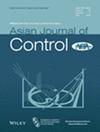采用 FlexRay 协议和混合网络攻击的二维位移变化系统的递归集合成员过滤
IF 2.7
4区 计算机科学
Q2 AUTOMATION & CONTROL SYSTEMS
引用次数: 0
摘要
本文研究了受 FlexRay 通信协议和混合网络攻击(HCA)影响的二维(2-D)系统的递归集合成员滤波器设计问题。FlexRay 协议集成了时间触发和事件触发机制,并涉及一系列基于双向度量的预定义通信周期,旨在减轻网络带宽负载。此外,设想中的系统还面临着以随机方式发生的虚假数据注入和拒绝服务攻击。随后,构建了受双向演化 HCA 和 FlexRay 调度协议影响的动态过滤错误系统(FES)。然后,利用双重数学归纳法和递归线性矩阵不等式(RLMI),获得了动态 FES 始终位于椭圆形集合内的充分条件。此外,还从矩阵迹线的角度出发,通过最小化椭圆约束给出了最优滤波算法。所提出的递归集成员滤波器设计方法的有效性通过一个长距离输电线路实例得到了验证。本文章由计算机程序翻译,如有差异,请以英文原文为准。
Recursive set-membership filtering for two-dimensional shift-varying systems with FlexRay protocol and hybrid cyber attacks
The problem of recursive set-membership filter design for two-dimensional (2-D) systems subject to FlexRay communication protocol and hybrid cyber attacks (HCAs) is investigated in this article. The FlexRay protocol that integrates time-triggered and event-triggered mechanisms and involves a series of pre-defined communication cycles based on bidirectional metrics is developed to alleviate the network bandwidth load. Furthermore, the envisioned system is exposed to false data injection and denial-of-service attacks that occur in a randomized manner. Subsequently, the dynamic filtering error system (FES) subject to bidirectional evolutionary HCAs and FlexRay scheduling protocol is constructed. Then, sufficient conditions are obtained such that the dynamic FES consistently resides within an ellipsoidal set by utilizing double mathematical induction and recursive linear matrix inequalities (RLMIs). Moreover, the optimal filtering algorithm is given by minimizing the ellipsoidal constraints from the perspective of the traces of the matrix. The effectiveness of the presented recursive set-membership filter design approach is validated by a long-distance transmission line example.
求助全文
通过发布文献求助,成功后即可免费获取论文全文。
去求助
来源期刊

Asian Journal of Control
工程技术-自动化与控制系统
CiteScore
4.80
自引率
25.00%
发文量
253
审稿时长
7.2 months
期刊介绍:
The Asian Journal of Control, an Asian Control Association (ACA) and Chinese Automatic Control Society (CACS) affiliated journal, is the first international journal originating from the Asia Pacific region. The Asian Journal of Control publishes papers on original theoretical and practical research and developments in the areas of control, involving all facets of control theory and its application.
Published six times a year, the Journal aims to be a key platform for control communities throughout the world.
The Journal provides a forum where control researchers and practitioners can exchange knowledge and experiences on the latest advances in the control areas, and plays an educational role for students and experienced researchers in other disciplines interested in this continually growing field. The scope of the journal is extensive.
Topics include:
The theory and design of control systems and components, encompassing:
Robust and distributed control using geometric, optimal, stochastic and nonlinear methods
Game theory and state estimation
Adaptive control, including neural networks, learning, parameter estimation
and system fault detection
Artificial intelligence, fuzzy and expert systems
Hierarchical and man-machine systems
All parts of systems engineering which consider the reliability of components and systems
Emerging application areas, such as:
Robotics
Mechatronics
Computers for computer-aided design, manufacturing, and control of
various industrial processes
Space vehicles and aircraft, ships, and traffic
Biomedical systems
National economies
Power systems
Agriculture
Natural resources.
 求助内容:
求助内容: 应助结果提醒方式:
应助结果提醒方式:


